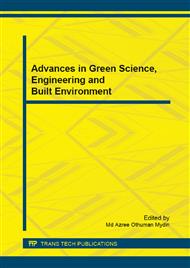p.88
p.93
p.97
p.101
p.105
p.109
p.123
p.127
p.132
The Characteristics of Residents at Low Cost Housing in Jakarta - Indonesia and their Culture to Green Principles
Abstract:
Low cost housing in Jakarta – Indonesia is provided by the government for low-income people in urban areas, in line with the program to redevelop or renew slum areas or densely populated neighborhoods for supporting sustainable living environment in urban area. Sustainable living environment will be achived if people who live in low cost housing have the culture which support and apply green principles. The purpose of research is to give knowledge about the change of life-cycle and life stage of low-income people as the first residents as long as they stay in vertical housing, and their culture to green principles. The research objectives are to determine the characteristics of residents as urban people and the factors which influenced, to know how their culture to apply green principles. The research was conducted at four low cost housing in Jakarta. The results showed that currently the families still have characters as informal-traditional, nuclear family and extended family. The residents generally are as employee or entrepreneur in informal sector, and still as low income family. Demographic, socio-culture, and economic are the factors which influenced life-cycle and life stage of low-income people as urban society. People who live in low cost housing still have traditional culture which support to green principles.
Info:
Periodical:
Pages:
105-108
Citation:
Online since:
March 2015
Authors:
Price:
Сopyright:
© 2015 Trans Tech Publications Ltd. All Rights Reserved
Share:
Citation:


